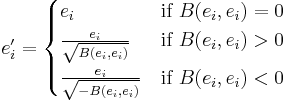Symmetric bilinear form
A symmetric bilinear form is a bilinear form on a vector space that is symmetric. Symmetric bilinear forms are of great importance in the study of orthogonal polarity and quadrics.
They are also more briefly referred to as just symmetric forms when "bilinear" is understood. They are closely related to quadratic forms; for the details of the distinction between the two, see ε-quadratic forms.
Contents |
Definition
Let V be a vector space of dimension n over a field K. A map  is a symmetric bilinear form on the space if :
is a symmetric bilinear form on the space if :
The last two axioms only imply linearity in the first argument, but the first immediately implies linearity in the second argument then too.
Matrix representation
Let  be a basis for V. Define the n×n matrix A by
be a basis for V. Define the n×n matrix A by  . The matrix A is a symmetric matrix exactly due to symmetry of the bilinear form. If the n×1 matrix x represents a vector v with respect to this basis, and analogously, y represents w, then
. The matrix A is a symmetric matrix exactly due to symmetry of the bilinear form. If the n×1 matrix x represents a vector v with respect to this basis, and analogously, y represents w, then  is given by :
is given by :
Suppose C' is another basis for V, with :  with S an invertible n×n matrix. Now the new matrix representation for the symmetric bilinear form is given by
with S an invertible n×n matrix. Now the new matrix representation for the symmetric bilinear form is given by
Orthogonality and singularity
A symmetric bilinear form is always reflexive. Two vectors v and w are defined to be orthogonal with respect to the bilinear form B if  , which is, due to reflexivity, equivalent with
, which is, due to reflexivity, equivalent with 
The radical of a bilinear form B is the set of vectors orthogonal with every other vector in V. One easily checks that this is a subspace of V. When working with a matrix representation A with respect to a certain basis, v, represented by x, is in the radical if and only if
The matrix A is singular if and only if the radical is nontrivial.
If W is a subspace of V, then  , the set of all vectors orthogonal with every vector in W, is also subspace. When the radical of B is trivial, the dimension of
, the set of all vectors orthogonal with every vector in W, is also subspace. When the radical of B is trivial, the dimension of  = dim(V) − dim(W).
= dim(V) − dim(W).
Orthogonal basis
A basis  is orthogonal with respect to B if and only if :
is orthogonal with respect to B if and only if :
When the characteristic of the field is not two, there is always an orthogonal basis. This can be proven by induction.
A basis C is orthogonal if and only if the matrix representation A is a diagonal matrix.
Signature and Sylvester's law of inertia
In its most general form, Sylvester's law of inertia says that, when working over an ordered field K, the number of diagonal elements equal to 0, or that are positive or negative, is independent of the chosen orthogonal basis. These three numbers form the signature of the bilinear form.
Real case
When working in a space over the reals, one can go a bit a further. Let  be an orthogonal basis.
be an orthogonal basis.
We define a new basis 
Now, the new matrix representation A will be a diagonal matrix with only 0,1 and −1 on the diagonal. Zeroes will appear if and only if the radical is nontrivial.
Complex case
When working in a space over the complex numbers, one can go further as well and it is even easier. Let  be an orthogonal basis.
be an orthogonal basis.
We define a new basis  :
:
Now the new matrix representation A will be a diagonal matrix with only 0 and 1 on the diagonal. Zeroes will appear if and only if the radical is nontrivial.
Orthogonal polarities
Let B be a symmetric bilinear form with a trivial radical on the space V over the field K with characteristic different from 2. One can now define a map from D(V), the set of all subspaces of V, to itself :
This map is an orthogonal polarity on the projective space PG(W). Conversely, one can prove all orthogonal polarities are induced in this way, and that two symmetric bilinear forms with trivial radical induce the same polarity if and only if they are equal up to scalar multiplication.









